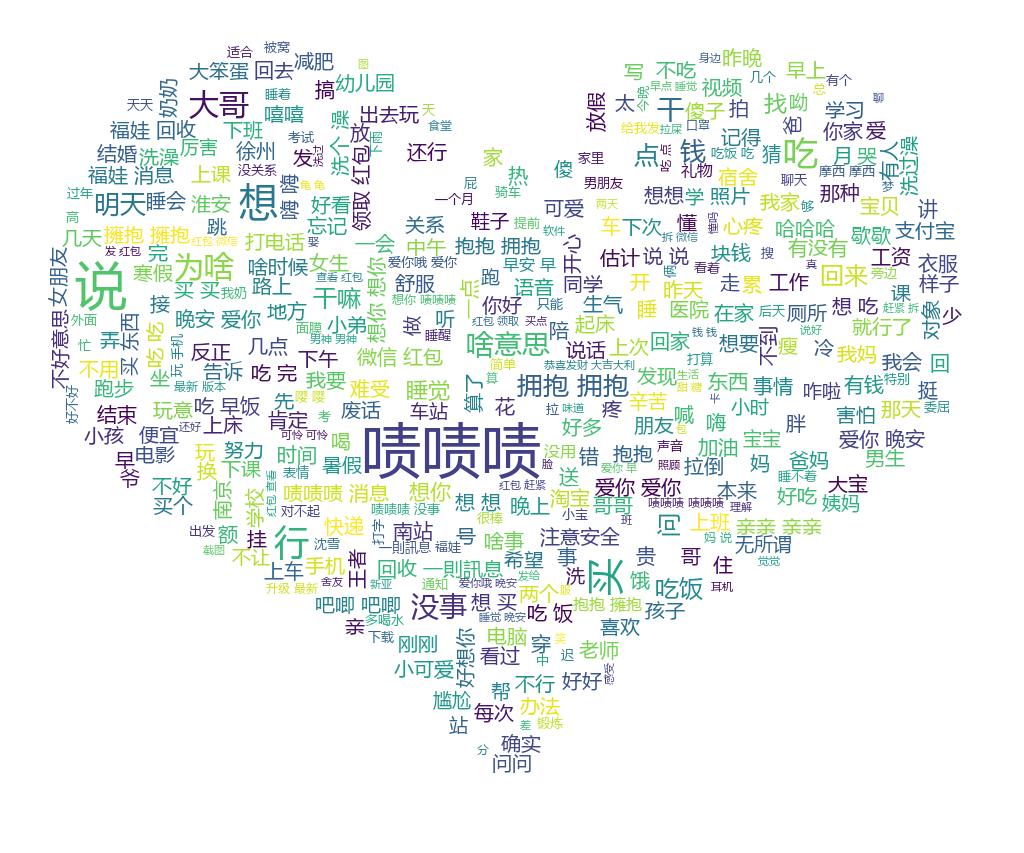偶然的一个想法,于是便去试了一试python的使用过程
获取数据
获取数据参考https://blog.csdn.net/Kevinxgl/article/details/109992360
- 电脑安装安卓模拟器(蓝叠)
- 用电脑微信备份需要的聊天记录至模拟器
- 模拟器获取root权限 找到数据库存放位置/data/data/com/tencent.mm/MicroMsg在这个路径下有两个以数字和字母命名的文件夹,其中有一个存放这数据库EnMicroMsg.db(通常文件大的)复制到pc上备用
- 获取数据库密码:
- 机器的IMEI:直接在模拟器上下载IMEI工具
- auth_uin :/data/data/com.tencent.mm/shared_prefs路径下的auth_info_key_prefs.xml中value值
- 计算密码:MD5在线加密工具,IMEI和auth_id,加密方式选择32位小。数据库密码就是前7位
其中的重点就是获取数据库,数据库软甲SqlLite Browser可以百度获取。导出位message时需要仔细寻找
Python对数据进行操作
- ide选择PyCharm 库主要用到 jieba pandas WordCloud 等
- WordCloud需要自己安装,PyCharm安装错误。
安装WordCloud可以参考->https://blog.csdn.net/qq_31673689/article/details/78745155
停用词表
代码分析见下图
1
2
3
4
5
6
7
8
9
10
11
12
13
14
15
16
17
18
19
20
21
22
23
24
25
26
27
28
29
30
31
32
33
34
35
36
37
38
39
40
41
42
43
44
45
46
47
48
49
50
51
52
53
54
55
56
57
58
59
60
61
62
63
64
65
66
67
68
69
70
71
| import csv
import re
from matplotlib import pyplot as plt
from wordcloud import WordCloud
from PIL import Image
import numpy as np
import jieba
import pandas as pd
jieba.load_userdict("dict.txt") #载入自定义词典,可以更好的分词
#读取csv文件数据 并且存储为dataframe格式
#datas=pd.read_csv('wx3.csv',usecols=['content'],encoding='utf-8',engine='python')
#=pd.DataFrame(datas)
#print(pf)
#pf.to_csv("wx.txt",encoding='utf_8_sig') 读取的数据写入到txt文件中
#读取txt文件
with open("wx.txt",encoding="utf-8") as f:
text=f.read()
#正则表达式,去除字母数字等
str = re.sub('[a-zA-Z0-9’!"#$%&\'()*+,-./:;<=>?@,。?★、…【】《》?“”‘’![\\]^_`{|}~\s]+', "", text)
#进行分词 icut()精确分词
wordlist = jieba.lcut(str)
#读取停词表内容,过滤不必要的数据
stopwords = [line.strip() for line in open('stop.txt', 'r', encoding='utf-8').readlines()]
#循环过滤
outstr = '' # 待返回字符
for word in wordlist:
if word not in stopwords:
outstr += word + " "
outstr2=outstr.split()
counts = {}
for word in outstr2:
if len(word) == 1: # 单个词语不计算在内
continue
else:
counts[word] = counts.get(word, 0) + 1 # 遍历所有词语,每出现一次其对应的值加 1
print("长度", len(counts.items()))
items = list(counts.items())
items.sort(key=lambda x: x[1], reverse=True) # 根据词语出现的次数进行从大到小排序
for i in range(10):
word, count = items[i]
print("{0:<5}{1:>5}".format(word, count))
#将列表元素以空格拼接起来
jieba_txt = " ".join(outstr2)
#生成词云
background_image = np.array(Image.open('wx.png'))
wordcloud = WordCloud(font_path=r'C:\Windows\Fonts\msyh.ttc', # 调用系统自带字体(微软雅黑)
background_color='white', # 背景色
max_words=400, # 最大显示单词数
max_font_size=60, # 频率最大单词字体大小
mask=background_image # 自定义显示的效果图
).generate(jieba_txt)
plt.imshow(wordcloud, interpolation='bilinear')
plt.axis('off')
plt.show()
wordcloud.to_file("词云图片.jpg")
|
下面是生成的照片

代码参考博客
https://blog.csdn.net/weixin_44301621/article/details/89510319
https://blog.csdn.net/weixin_43746433/article/details/89856014
个人小结
- 最重要的是要多看文档,遇到不认识的方法要搞清楚参数及其的意思
- 思路最重要,按步骤执行就行




